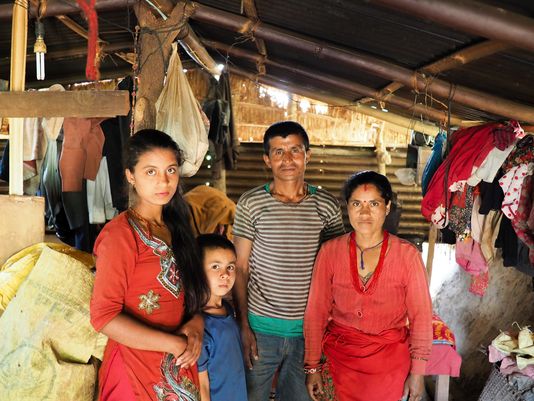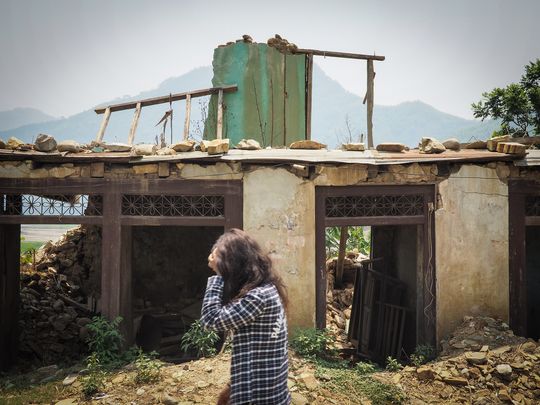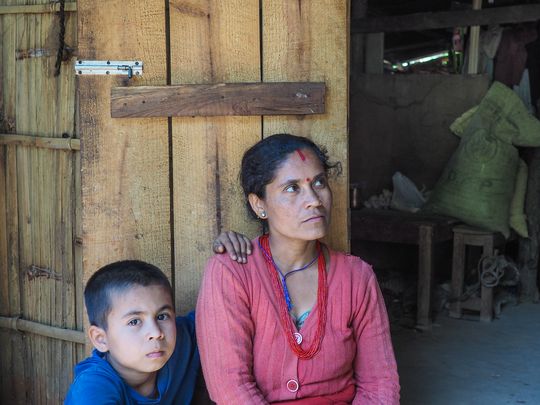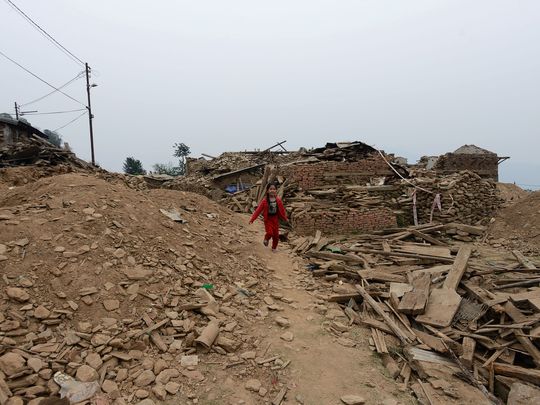Nepal still reeling from devastating 2015 earthquake

KATHMANDU, Nepal — Usha Pandey was dancing when the earthquake hit. She was at home with her younger sister and brother on a school holiday, listening to music and having fun.
"As soon as the house started shaking, we ran outside," Pandey, 19, said. "The house collapsed right afterward. We're lucky to be alive. I still feel scared remembering it."
But the problems were just beginning.
One year after the magnitude-7.8 earthquake devastated Nepal and killed nearly 9,000 people, the Pandey family still hasn't moved back home. They're living in a small temporary shelter across the road from their damaged house, in the rugged hills of Nuwakot District, about 50 miles from Kathmandu. The family of five shares a cramped wooden shed with some unwelcome guests.
"There are scorpions," said Pandey's mother Saraswoti, 40. "The other night, I saw a snake hanging down from the ceiling," she said. During monsoon season, rain comes pouring in through the tin roof. In the winter, they try to plug up drafts with hay and build bonfires outside.
The only relief that reached the Pandey family was a tarp and some bulk rice and lentils. They haven't received any rebuilding assistance from Nepal's government, which has faced criticism at home and from international donors for its handling of one of biggest natural disasters in the country's history.
Although $4.1 billion in international aid has been pledged by donors, only a small fraction has been committed and disbursed. In the meantime, all over the earthquake-impacted zones, families are still living in temporary shelters — some 3 million people, according to aid group Save the Children.
While initial relief efforts were fairly robust, red tape, political infighting and inefficiency have hobbled the rebuilding process.
Nepal's parliament passed a new constitution in September 2015, which led to political tensions among the diverse ethnic communities. Protesters at the Indian border began a blockade that lasted more than four months, causing severe shortages of fuel and other supplies across Nepal.
The country also dragged its feet in establishing the Nepal Reconstruction Authority, which began operations in January, more than seven months after the earthquake that damaged or destroyed more than 900,000 homes. Costs of damages and losses are estimated at $7 billion, according to the government.
Kenichi Yokoyama, country director of the Asian Development Bank, which has pledged $200 million to the reconstruction efforts, said the government’s response has been sluggish.
“The government could have a much stronger sense of vigor, emergency and urgency,” Yokoyama said.
Yokoyama said many of Nepal’s problems in responding to the earthquake are systemic, due to a lack of technical capacity and infrastructure. Nepal is ranked as one of the least-developed countries by the United Nations.
“We need to accept the reality that there is very significant capacity constraint, which needs to be addressed by providing sufficient technical assistance much beyond funding,” he said.
While international donors such as ADB are still waiting for their funds to be utilized, aid groups on the ground like the Red Cross have been constrained by an inconsistent government process.
“You often don’t know who is taking the decisions,” said Max Santner, head of delegation for the International Federation of Red Cross and Red Crescent Societies in Nepal. “It is like negotiating against a rubber wall.”
He said that before the earthquake, Nepal was already suffering from heavy pressure on its natural resources and from a government that has neglected development of the most basic social services, which exacerbated the slow recovery.
“In such an exceptional situation, I expected (the response) to be like this,” Santner said. “It is not a surprise at all.”
Complicating the rebuilding efforts is a social caste system and discrimination among the dozens of ethnic groups in Nepal, according to a March report by Save the Children.
“The earthquakes occurred in the context of deeply entrenched social hierarchy, and associated with that hierarchy, deeply entrenched social exclusion — with vulnerable and marginalized groups having suffered a history of discrimination due to caste, gender, ethnicity, religion, age, disability, language and/or geographical remoteness,” the report said.
In the remote village of Dhadkharkh in Nuwakot District, all 160 homes were destroyed by the earthquake and only two are being rebuilt, with private funds. Dev Bahadur Tamang is the village shaman, a traditional healer and spiritual leader. He said the villagers have heard rumors that the government will be providing funds for new houses, but no one from the government has come to the village.
"We are very frustrated and very confused,” he said. “Now the monsoon season is coming again and it will be impossible to rebuild.”
Tamang said that many in the village still fear another earthquake and would like to relocate but have nowhere to go. They can only pray that aid will reach them eventually.
“I hope after two or three years the village will come back to life,” Tamang said. “If we don’t have money, we will spend the rest of our lives in temporary shelters.”
Политика конфиденциальности | Правила пользования сайтом











